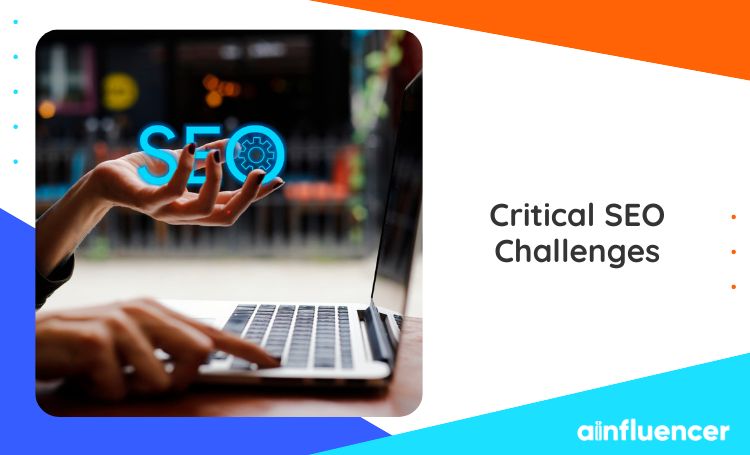SEO will continue to be important for businesses with a consistent online profile in the growing age of technology. Still, the ever-changing nature of search engine algorithms proves to be quite problematic to SEO specialists and web admins, causing some critical SEO challenges.
Such complete and unsystematic updates can significantly change a website’s ranking and websites’, let alone visibility. This article provides a closer look at the most critical SEO challenges in the context of algorithm changes and ways to operate in this environment successfully and improve your website ranking.
1. Understanding the Impact of Algorithm Updates
“Earlier algorithm modifications aim to improve the quality of the search results, but simultaneously, the websites’ position can dramatically be used. For example, Google actively develops and releases core updates several times a year, each of which could further change ranking factors like content quality, page loading speed, and user experience.
Such updates have severe effects that differ in that the traffic on some sites drastically reduces, and others increase. To respond to these critical SEO challenges, one needs to monitor such changes with the help of trustworthy sources, including Google Search Central and reliable SEO influencers, and constantly analyze the website’s statistics.
An update impacts the website’s most essential parts of your SEO, which enables you to correct any loss or enhance gain in rankings,” adds Sarah Jeffries, Director at Paediatric First Aid
2. Maintaining Content Relevance and Quality
“In SEO, one of the most significant barriers is ensuring that the placed content is still valuable and high-quality when updating the algorithms. The trend of trying to rank by linking alone will only work if the search engines have begun to factor in the relevance of the content to the search query.
However, content has to be appropriate in providing sufficient information to meet the need or answer the user’s question. To maintain updated content, one is supposed to update their content frequently after some time, integrate items such as videos and infographics, and ensure that the content is easily scannable, according to Lauren Taylor, Marketing Manager at Emergency First Aid At Work Course.
Secondly, optimizing for relevance is much more effective than optimizing for ranking, which is why a user-first approach to content creation can have quite a strong positive impact on a website’s performance in SER.
3. Adapting to Changing Keyword Strategies
“Keyword strategies that were efficient some years back may not be the same today because of the many algorithm changes. Today’s search instruments include novelties such as NLP and semantic search, meaning the search engine cannot consider the context behind the entered vital phrases.
This shift represents more work regarding keyword searches and their further utilization. Thus, the usefulness of such keywords might be significantly lower, not only because the metered traffic they attract is usually a total of low-quality and spammy queries, but because one should always look at long-tail equivalents of such keywords, their semantic variations and topics that cover similar intent.
Google’s Keyword Planner and SEMrush can be used to unveil these trends and enable authors to embody the needs of the users and local SE standards, explains Youssef Hodaigui, SEO Pro at Net Biscuits
4. Coping with the Rise of AI and Machine Learning
” Recent developments, such as incorporating AI and machine learning in search engine algorithms, have made some critical SEO challenges. Google’s RankBrain and BERT – natural language processing- also help adjust search results based on user behavior in real time.
These AI updates are centered mainly on the meaning of the phrases used by users, meaning that SEO has to be a lot more than mere keyword-based optimization.
Thus, as a response to this transition, SEO specialists should concentrate on the production of topical and valuable content and optimization of the websites for CTR and time spent on the website, as well as remaining flexible to the role of AI in the search process,” advises Yassine Zaid, SEO Strategist at Lairdand Partners.
5. Navigating Mobile-First Indexing
Gerrid Smith, Chief Marketing Officer at Joy Organics, says, In recent years, web indexing has shifted to mobile-first, meaning that search engines use the mobile version of the site for indexing and ranking.
This is a problem with websites that need to be more friendly to mobile phones; hence, there is a need to develop Windows-friendly websites for mobile phones. Mobile-first indexing provides that even if you have a well-optimized site for the desktop, its ranking will be negatively impacted if it fails on mobile.
To cater to these critical SEO challenges, your site should be mobile-friendly and load those pages quickly, with straightforward navigation and easily readable content on the small screen. Check your site Google’s like Google’s Mobile-Friendly Test, and evaluate whether they cause concern.
However, it is not only related to design but also to such SEO aspects as mobilized content with shorter, less-featured texts and large” touch buttons.
6. Dealing with E-A-T (Expertise, Authoritativeness, Trustworthiness)
“Over the years, the E-A-T framework has grown significant in SEO, particularly for websites operating in health, finance, and legal industries. Another common brute-force approach is to factor in content with high topical expertise, authoritativeness, and trustworthiness.
To achieve these standards, the best approach is to post articles that are as professional as possible- they should be verified and authored or edited by experienced experts in that topic area.
Cannabiz Collects, a top cannabis debt collection agency, emphasizes the critical role of E-A-T in the highly regulated cannabis industry:
“This extends to sectors such as cannabis, where legal formulation and financial precision are cornerstones for success; it is advantageous and critical to establishing E-A-T.
With a focus on delivering expert solutions for outstanding debt recovery, our content is immaculate, the backlinks from authoritative sources are earned, the team’s credentials are displayed, and all statements are verified – this is how we build trust with the readers and ensure that our site complies with Google’s Quality,” says Brett Gelfand, Managing Partner at Cannabiz Collects.
Building E-A-T also involves:
- Securing high-quality backlinks from reputable sources.
- Showcasing author credentials.
- Please be sure to ensure transparency in your site’s content and policies.
Google’s Quality Rater Guidelines provide valuable insights into what constitutes high E-A-T, making it a critical resource for any SEO strategy.
7. Managing Technical SEO Amidst Algorithm Changes
Technical SEO is fundamental to optimization, but frequent algorithms update the fundamentals of technical SEO and its importance.
For instance, the recent Google Core Web Vitals update focused on aspects of page experience such as speed, interactivity, and visual stability. Indexing, site speed, HTTPS, and structure data updating are a few site technicalities that should be audited occasionally to experience a robust ranking status.
Greg Lindsay from Aardvark Exterminating, a Pest Control Company in Athens, GA, emphasizes the importance of technical SEO for local businesses: >Pest control, where local search visibility is paramount, keeping tabs on technical SEO is essential in reaching customers.
Stay current with the on-site SEO technical factors using Google Search Console and Lighthouse; these tools helped us continually check the sites’ loading speeds, security, and usage experience.
We, therefore, ensure that our pest control business retains an excellent online presence in Athens, GA, because of the technical SEO optimization.
It is always important to know what is going on regarding critical SEO challenges and the guidelines and policies of any search engines; in that way, you will always ensure that your site is technically correct and as closely in line as possible with the current standard of policies regarding search engines. “.
8. Mitigating the Impact of Negative SEO and Penalties
“It is expected that updating an algorithm means getting penalties for the acts previously allowed and now considered black-hat strategies. Critical SEO challenges like Negative SEO, where competitors get into the act of developing toxic backlinks that will reduce your ranking, are also/maturing.
Such risks can be managed by actively monitoring the backlink profile using tools such as Ahrefs or Moz. Staying clean from harmful backlinks and following search engine rules ensures your site doesn’t fall foul of penalties.
Also, it will be helpful to note that creating a good and positive image through the high quality of materials published, active visitor participation, and fair SEO methods will help protect the site from the negative impact of the changes.” says Daniel Foley, Founder of Daniel Foley SEO Consultancy.
Conclusion
Navigating the critical SEO challenges in the age of algorithm updates requires a proactive and adaptive approach. As search engines refine their algorithms, focusing on user experience, content quality, and technical excellence becomes increasingly essential.
By staying informed about changes, prioritizing high-quality content, optimizing for mobile, and adhering to best practices in technical SEO, businesses can maintain strong search engine rankings and thrive in the competitive digital landscape.
Ultimately, success in SEO is about staying agile, continuously refining strategies, and being prepared to adapt to whatever changes the future holds in search algorithms.









